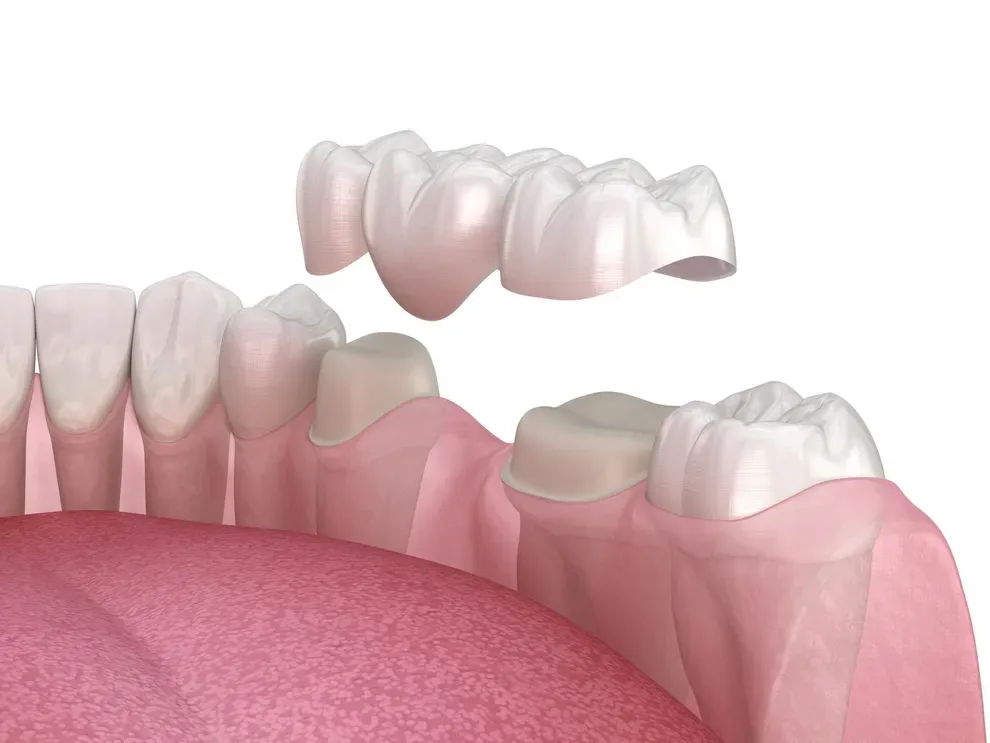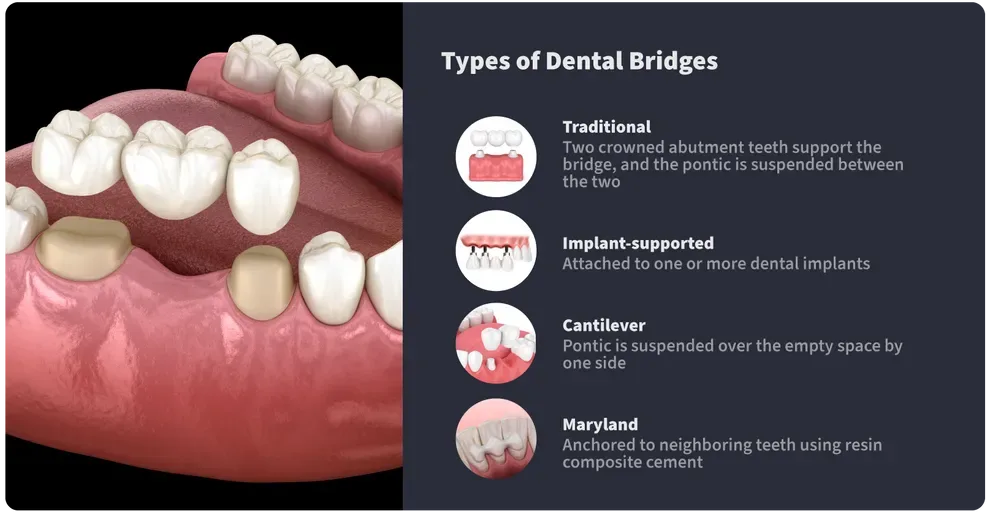An Overview of Dental Bridges: Types, Alternatives, Costs & More

Table of Contents
- Who Needs a Dental Bridge?
- Types
- Alternatives
- The Procedure
- Aftercare
- Risks
- Dental Bridge Care
- Costs
- Frequently Asked Questions
- References
A dental bridge is a prosthetic used to replace one or more missing teeth. It is attached to the teeth on either side of the missing tooth using dental crowns that are joined together with a false tooth suspended in the middle.
Dental bridges look a lot like natural teeth and make it easier for you to speak and chew. They are easy to care for and can last for 10 years or more with good oral hygiene. Common alternatives to dental bridges include dentures or implants.
Who Needs a Dental Bridge?
Anyone who has lost one or more of their natural teeth could benefit from a dental bridge. A bridge will help you chew and speak more easily and restore your natural smile.
Most bridges are crafted to replace just one tooth because this configuration is the strongest and most stable. However, it is possible to replace up to four teeth with a bridge if needed.
The more teeth you need to replace, the less practical a dental bridge becomes. If you are missing a significant number of teeth, it may be more effective to replace them with other prosthetics, such as dentures or implants.
Types

There are four types of dental bridges in use today: traditional, implant-supported, cantilever and Maryland.
A traditional dental bridge is made up of three joined pieces: two crowned abutment teeth, the teeth on either side of the gap that will support the bridge, and the pontic, the false tooth that will be suspended between the two abutment teeth. The bridge is attached to the abutment teeth just like dental crowns would be, and the pontic fills the space where your missing tooth would have been.
These bridges are attached to one or more dental implants instead of abutment teeth. These bridges are very strong and work well when you're missing more than one tooth, but they also cost significantly more than versions that do not require implants.
These are placed when patients want to replace a tooth that is missing at the end of their arch. There is no other tooth to attach the bridge to, so the pontic is simply suspended over the empty space by one side.
These bridges are anchored to neighboring teeth using resin composite cement instead of being attached to dental crowns. They are less expensive and conserve more of your natural tooth material, but they are very delicate. They can only be used to replace teeth in the front of the mouth, and people who have one are advised not to bite directly into things like apples or pizza crusts.
Dental bridges can also be made from several materials, including:
Porcelain
Ceramic
Glass ionomer
Zirconia
Resin composite
Precious metals such as copper and gold
Silver alloys
Alternatives
Dental bridges are not the only prosthetic used to replace a tooth. Dentures and implants are two other common prosthetics used to replace missing teeth. Dentures are usually less expensive than bridges but can be uncomfortable and inconvenient to wear. They also rarely look as much like a natural tooth as a bridge would.
Dental implants are more expensive than bridges but provide superior function and durability. They also do not require the teeth next to the missing tooth to be altered in any way. However, not everyone is a good candidate for an implant. If you are in poor health, have poor oral health, or have suffered extensive bone loss, dentures or bridges may be your only options.
The Procedure & Aftercare
A dental bridge placement procedure is very similar to a crown placement procedure. It usually takes at least two visits to complete.
The first part of this process is an oral health exam. Your dentist will check the status of your teeth and gums and possibly evaluate your jawbone as well. They may also take x-rays to get a better picture of what is going on inside your mouth.
When your dentist is confident that your mouth is in good enough shape for the procedure, they will administer a local anesthetic in the area where the bridge is being placed. This will keep you from feeling any pain during the procedure.
Once you are numb, your dentist will begin to reshape your abutment teeth to allow your new bridge to fit over them. By the time they are finished, your teeth will be much smaller and shaped like pegs, much like they would be if they were being prepped for crowns.
Your dentist will then take impressions of your abutment teeth and the space between them. They will use these impressions as a temporary bridge in your mouth to cover your reshaped teeth. This bridge is made of inexpensive but weak materials that will not last long because it will be replaced by your permanent bridge in a few weeks.
Aftercare
After the procedure, you may feel some general soreness in the area around your bridge, as well as some sensitivity to hot and cold. These symptoms will go away in a few weeks, but in the meantime:
Avoid hot and cold food and drink
Avoid sticky, hard, or crunchy food
Apply an ice pack to the outside of your jaw to control the swelling
Use over-the-counter pain medication if needed
Risks & Possible Complications
Dental bridges are considered safe and pose few risks. Most people will not need to go under general anesthesia to have a dental bridge placed. This eliminates the possibility of anesthesia-related complications.
Over time, you may develop decay under the crowns of your bridge or along their margins where the tooth underneath shows through. If this happens, you will need to have your crown removed to treat the decay, then have a new crown placed over your reshaped tooth.
If your dental bridge is only anchored to one tooth or spans too many missing teeth, your bridge may have a higher risk of breaking. If this happens, the teeth that are supporting it may also break. This rarely happens because most dentists will advise patients not to choose a bridge if
Dental Bridge Care
Caring for a dental bridge is a lot like caring for your natural teeth. Top tips are:
Brush your teeth at least twice a day. Spend at least two full minutes brushing each time and use an ADA-approved fluoride toothpaste. If you want to be extra careful, spend extra time brushing around your bridge.
Floss your teeth at least once a day, including the abutment teeth that support your bridge.
Eat a healthy diet with plenty of vitamin-rich fruits and vegetables and minimal added sugar.
See your dentist for regular dental checkups at least once every six months.
Costs
A dental bridge usually costs more than a denture but less than an implant. Depending on your needs, you can expect your bridge to cost anywhere from $1,100 to more than $12,000. The main factors that determine a bridge’s cost include:
The type of bridge you choose. Maryland bridges are the least expensive, while implant-supported bridges usually cost the most.
The size of the bridge. The more pontics you need, the more expensive your bridge becomes.
The materials used. Bridges made from high-end materials such as porcelain, ceramic, or gold cost more.
The skill and location of the dentist placing the bridge. Highly skilled dentists with offices in large cities usually charge more for their services.
If you’re not sure if you can fit the cost of a bridge into your budget, talk to your dentist. They can provide you with a more accurate estimate of what this will cost. They can also tell you whether your bridge is likely to be covered by your dental insurance.
Lastly, don’t forget that you can use funds in your HSA or FSA to pay for a dental bridge. This can help cover some of the costs and make the expense more manageable.
Frequently Asked Questions
Dental bridges typically last five to seven years. If you practice excellent oral hygiene and see your dentist regularly to avoid secondary decay, they can last much longer – sometimes several decades.
No. In fact, it is usually easier to eat with one than without one. This is because the bridge provides an additional hard surface that you can use to chew your food.
Possibly, but if it does, it will be for the better. Many people have difficulty producing certain sounds if they are missing one or more of their front teeth, leading to garbled speech. Replacing those teeth with a dental bridge restores the structures that were missing, making it easier to form words and speak clearly.
The cost of a dental bridge varies depending on many factors, including which materials are used and how large the bridge is. If you ask, your dentist, they can give you an estimate of how much your bridge might cost.
